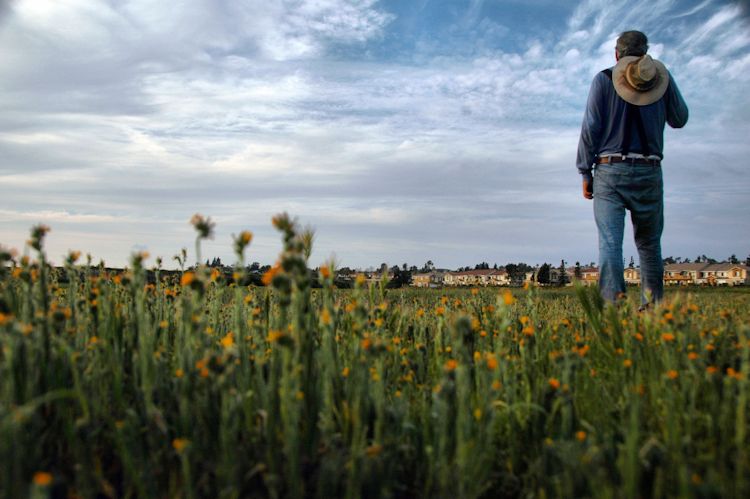Pax Nortona – A Blog by Joel Sax
From the Land of the Lost Blunderbuss
Home - Travel - Travels - So Cal - The King Tut Exhibit
The King Tut Exhibit
Posted on July 19, 2005 in Travels - So Cal
 The exhibit took place at LACMA on Museum Row, in a building that used to be the May Company. The parking lot attendant took our five dollars and gave us two flyers — just in case we were separated or didn’t know each other, I suppose — that told us where to park and where to find the Big Show. Lynn studied hers; I followed the signs. A elderly and thin African American guard stood at the entrace of LACMA all by himself. He wore a maroon jacket and waved us off to his right. King Tut. That way. I’m here just in case you can’t read the signs, recognize the golden head, or understand which way the arrow is pointing.
The exhibit took place at LACMA on Museum Row, in a building that used to be the May Company. The parking lot attendant took our five dollars and gave us two flyers — just in case we were separated or didn’t know each other, I suppose — that told us where to park and where to find the Big Show. Lynn studied hers; I followed the signs. A elderly and thin African American guard stood at the entrace of LACMA all by himself. He wore a maroon jacket and waved us off to his right. King Tut. That way. I’m here just in case you can’t read the signs, recognize the golden head, or understand which way the arrow is pointing.
Heat rained down from the sky and rained up from the asphalt next to the exhibit building. Planners had arranged for a half circle of refreshment booths — none of which sold the caffeine free diet cokes that I like — and placed a few round tables where people could sit. Beyond this was a big white tent where people could have the pleasure of waiting for their time in the exhibit. (They tell you when you can go in, but you can come out when it suits you.) Lots of women wearing classic California sun clothing — tight black pants and loose blouses or tank tops. Men wore t-shirts and walked around reading each other’s slogans. I had on my favorite button down white shirt. It matched the First Aid booth.
We got some cold water and then got in line where we stood for all of five minutes before they opened the door twenty minutes early and let us in.
What was inside: Lots of gold, wood, and lapis lazuli. The curators made a point of including objects from Tut’s predecessors. Large signs guessed the genealogy of Tut, speculating that he’d come from the line of Kiya rather than the more famous Neferititi. People were mostly well behaved except one old woman being pushed around in a wheelchair. From time to time, she’d rise and slip in just in front of me or someone else, leaning into the glass to scry the description of the artifact. She didn’t look at the pieces, just read the signs. I started to feel that she was following me, so I shifted the order of my visits to the glass boxes. This seemed to remedy the problem as far as I was concerned.
Gold, gold, and more gold. Most of it gold leaf, but here and there a solid piece like the falcon medallion (actual size!) that the boy pharoah wore around his neck. An old Steve Martin song, “I’d like a tomb like Old King Tut” swam in my head as I studied relics from the Middle Dynasties. Lynn was fascinated by the story of Tut’s father, Aten, who tried to replace the old gods with the worship of the sun, Ra. We didn’t talk much except to point out an especially interesting statue or object. Your head had plenty of discourse with the signs and the relics themselves: they were your company.
One time I did speak to Lynn was when we beheld an alabaster bust of Tut. “Hmmm. I don’t know,” I said. “He looks too much like Michael Jackson.”
“Yes, but without the bad nose job,” said Lynn.
The grand crescendo of the exhibit followed that: the tomb itself. Plenty of videos, graphic displays, and objects found with the corpse but no sarcophagus, no mummy, and no great golden head like the one used to draw us to buy tickets. The Egyptians kept those this time.
The only thing left to do was to watch a video describing the autopsies and MRI scans of the mummy, then go out to the gift shop where I bought a book about cats in ancient Egyptian society — the poor man’s lion is how they described my favorite domestic beast. Then we went over to Lacma proper for more cold water and a packet of key lime flavored candies. A brief walk around the gardens and balconies gave us views of an Alexander Calder fountain and the silly mastadon statues at the La Brea Tarpits.
We ate Ethopian food, using pieces of folded up bread to scoop up the meat and vegetables. The dough was sour. California sour dough originated when 49ers mixed flour and yeast in sacks and then got it wet. How long had Ethiopians used this mixture for their crepe-like flat bread? I ate eternity.

